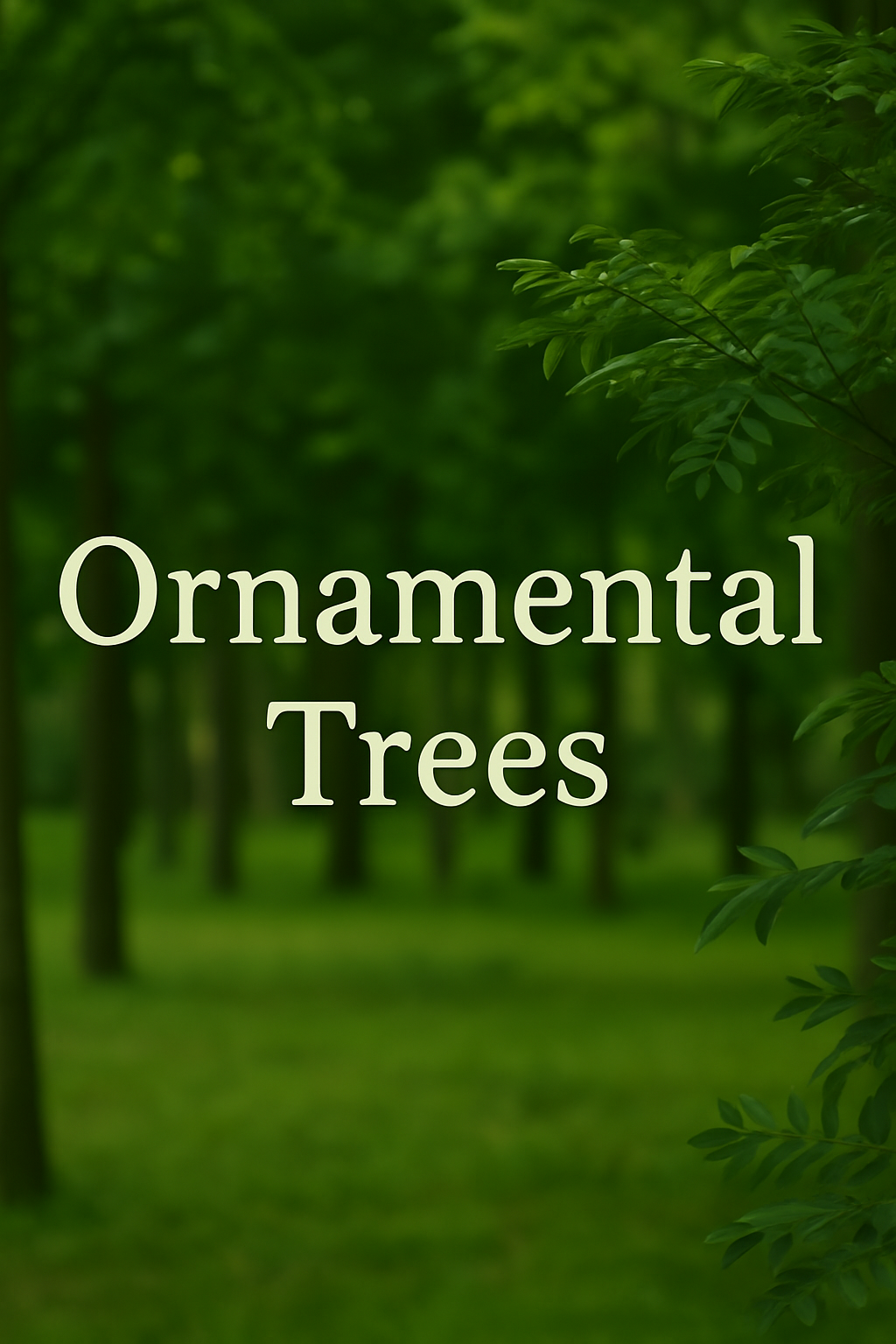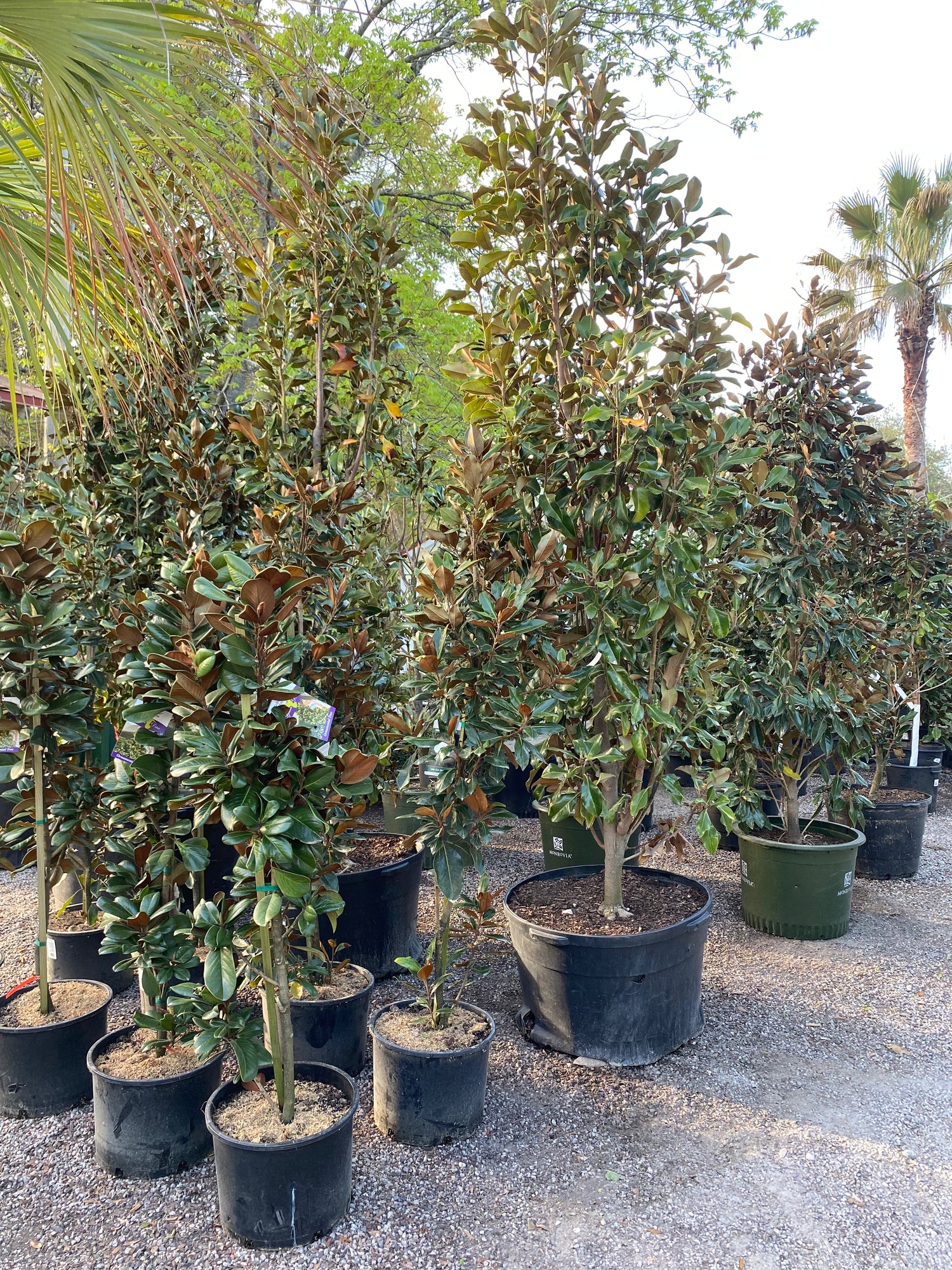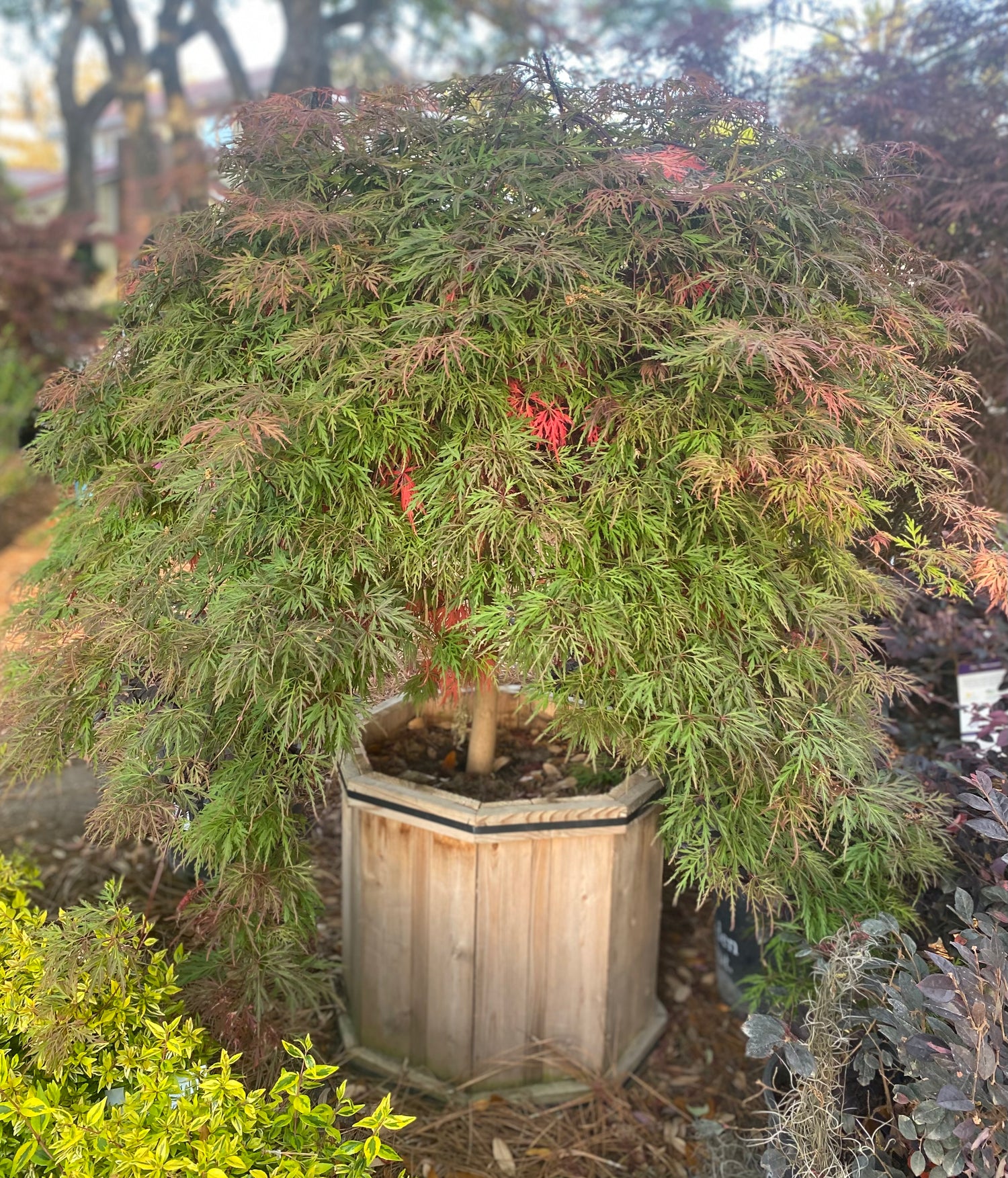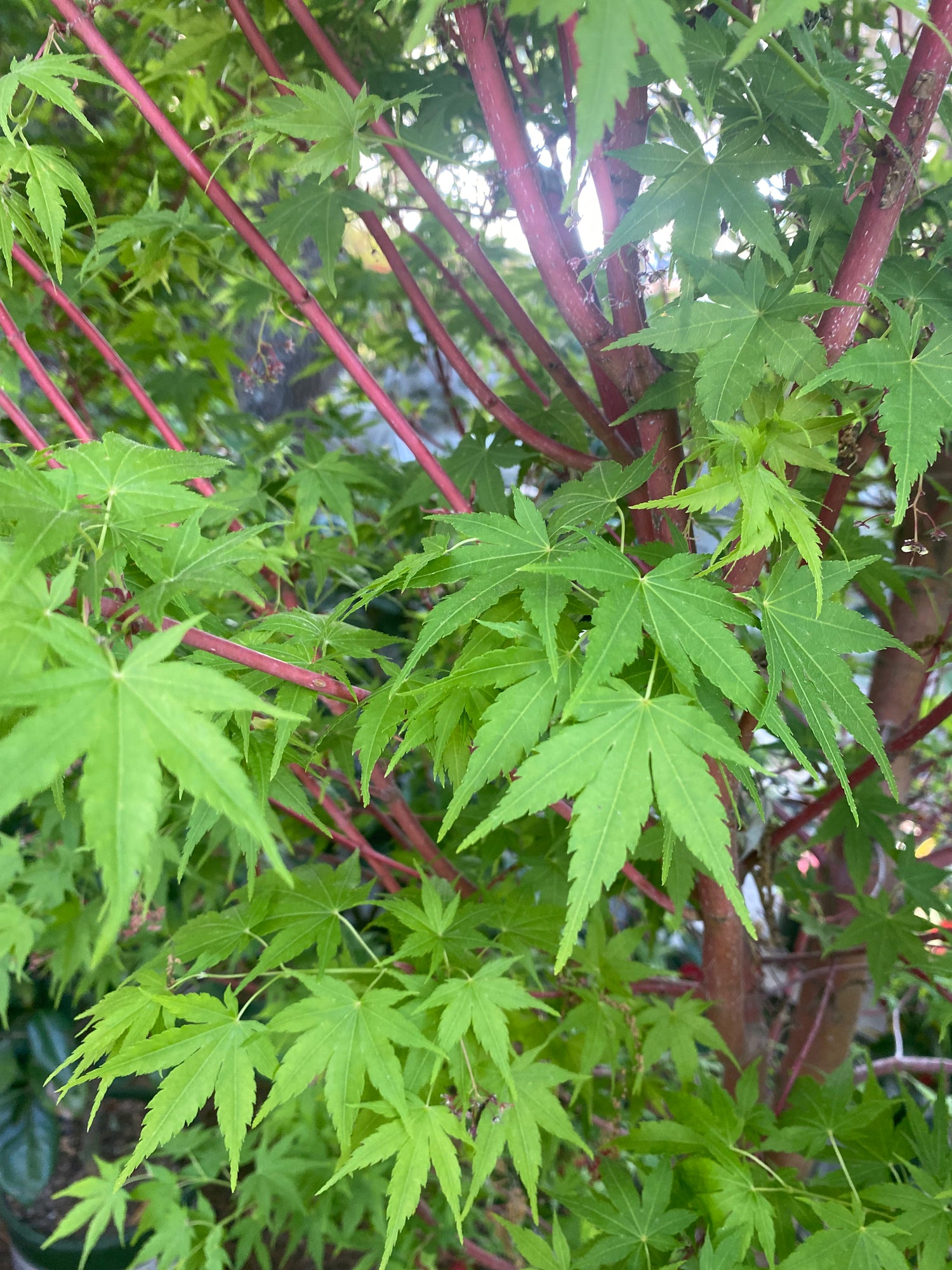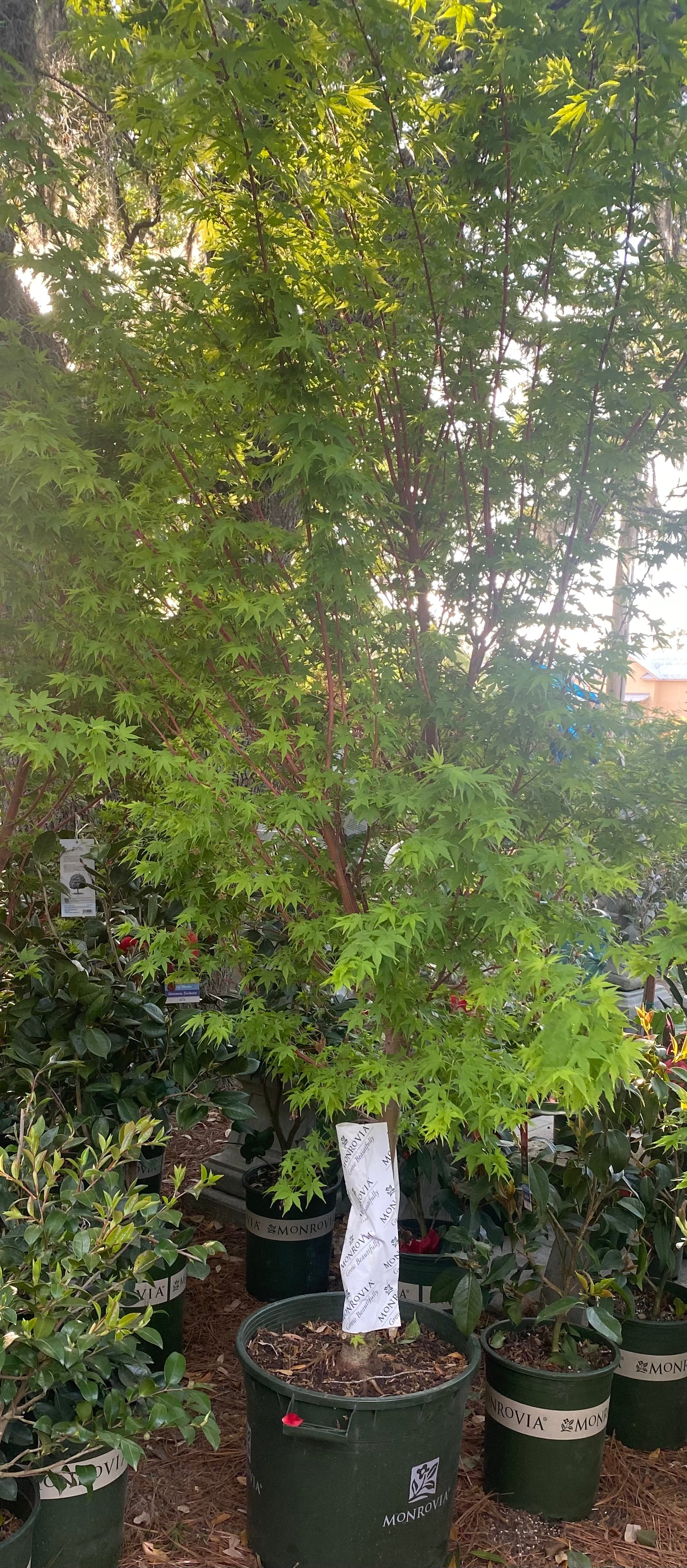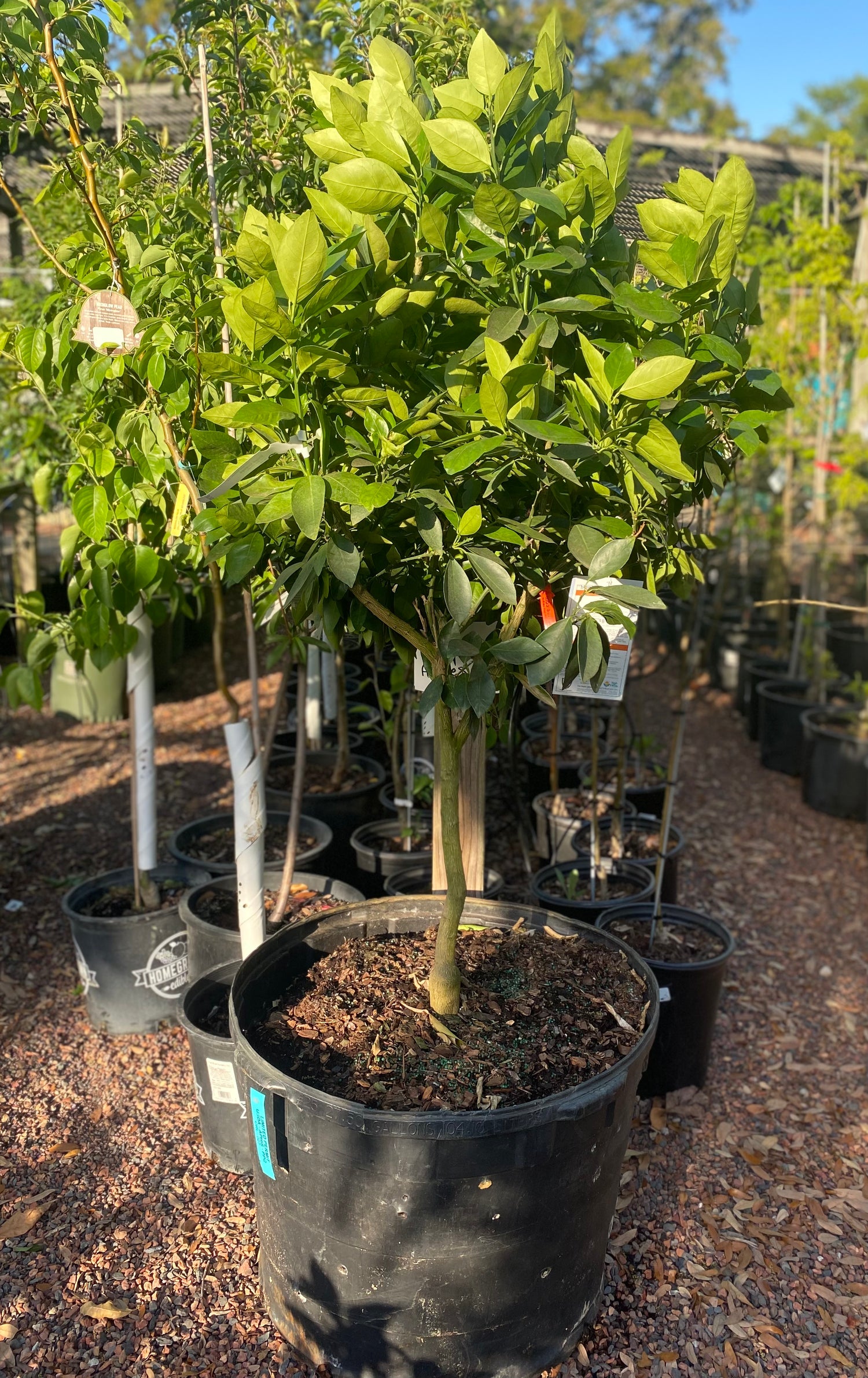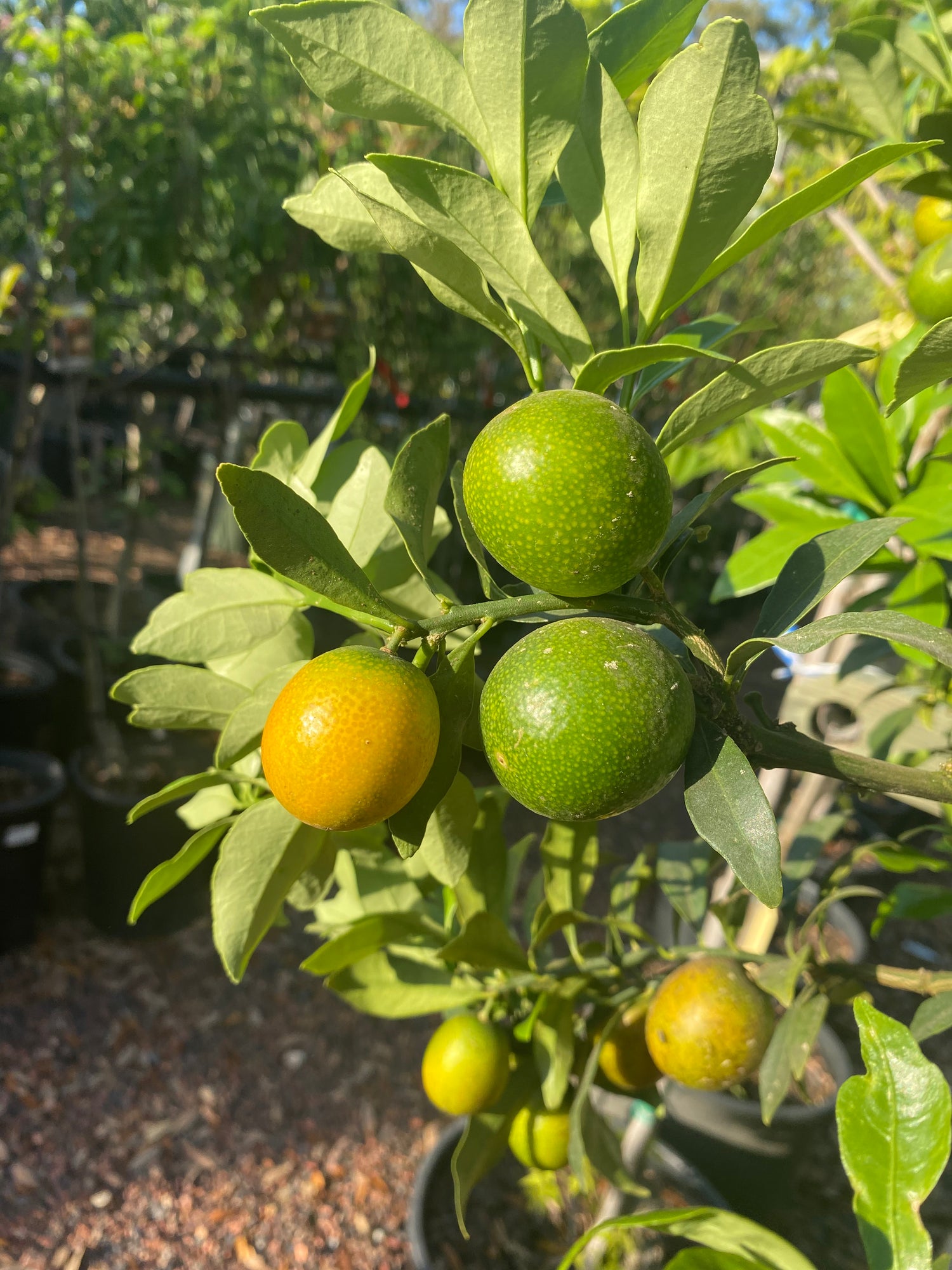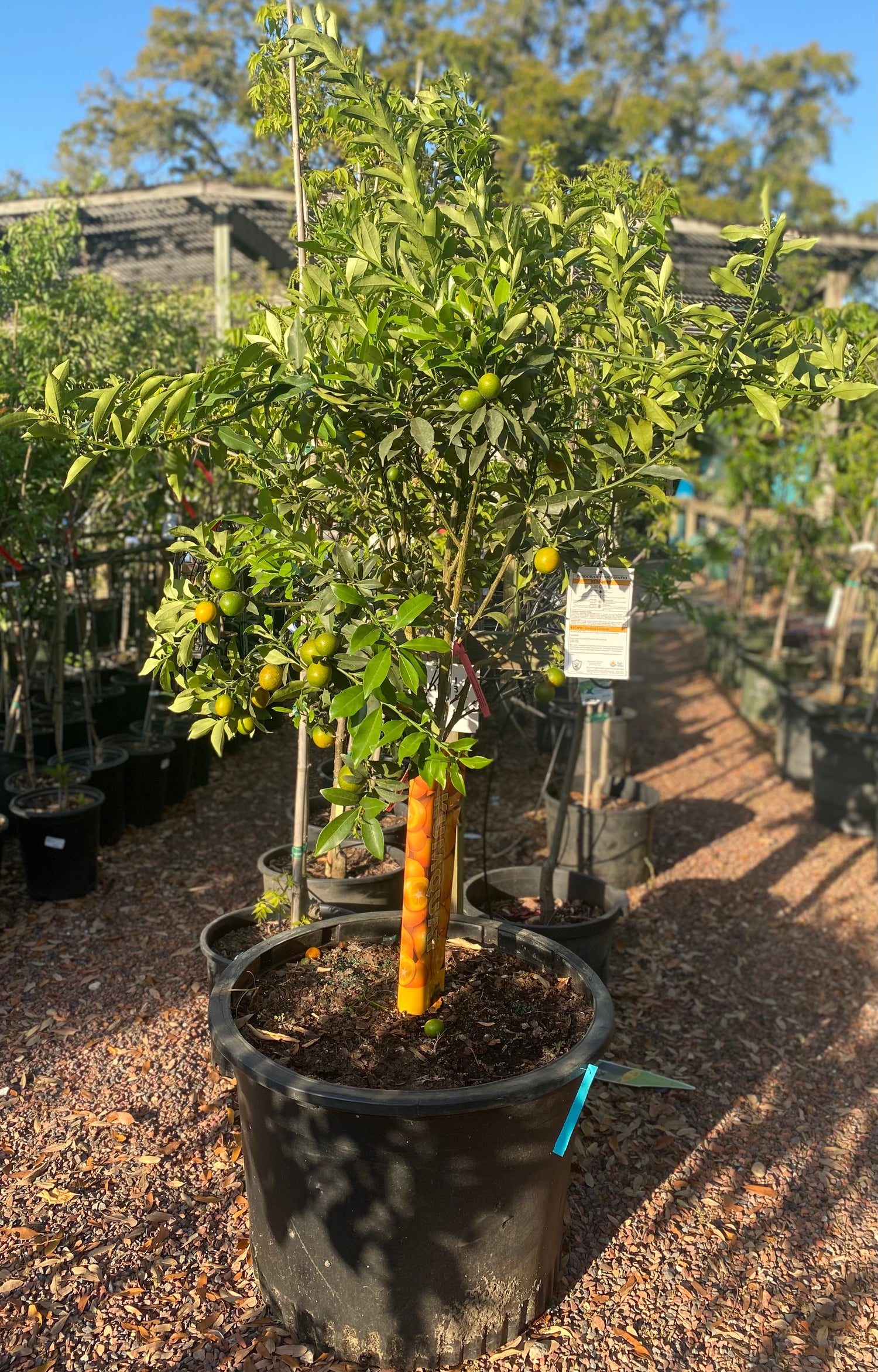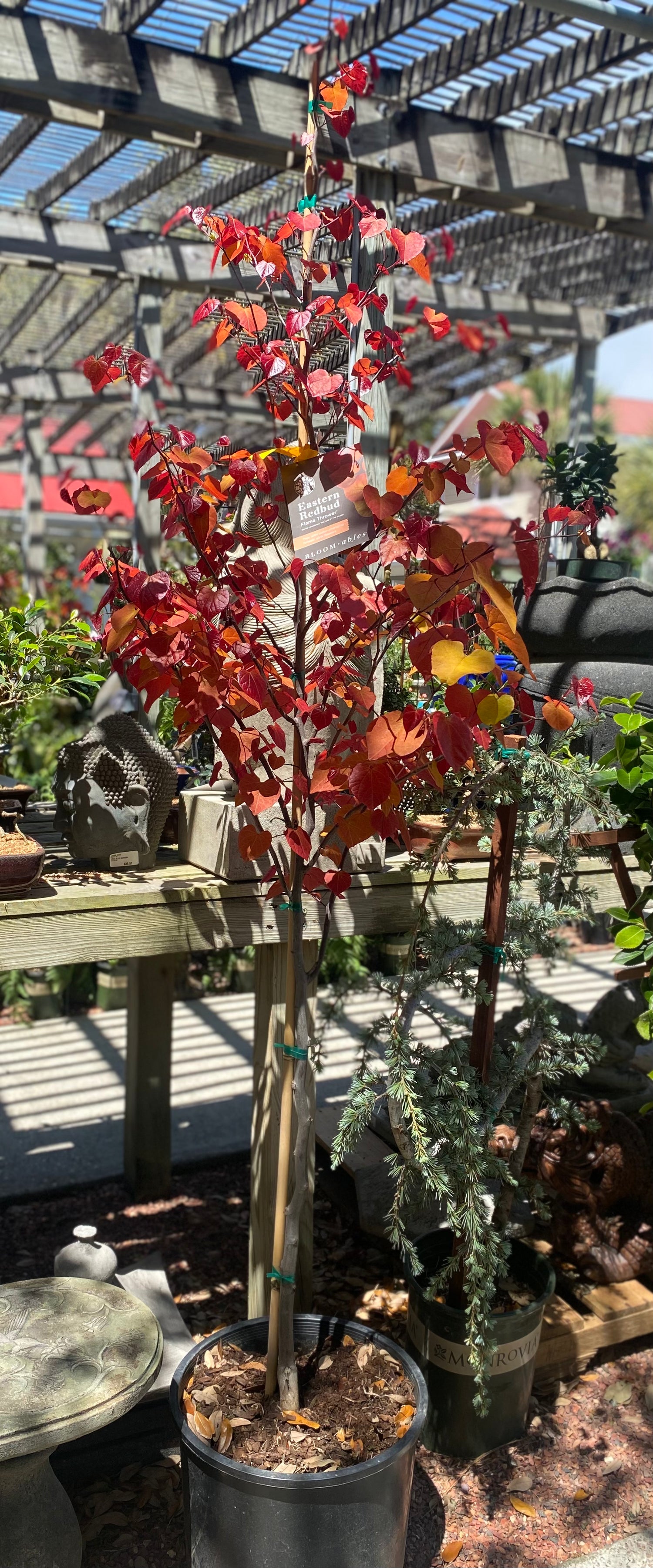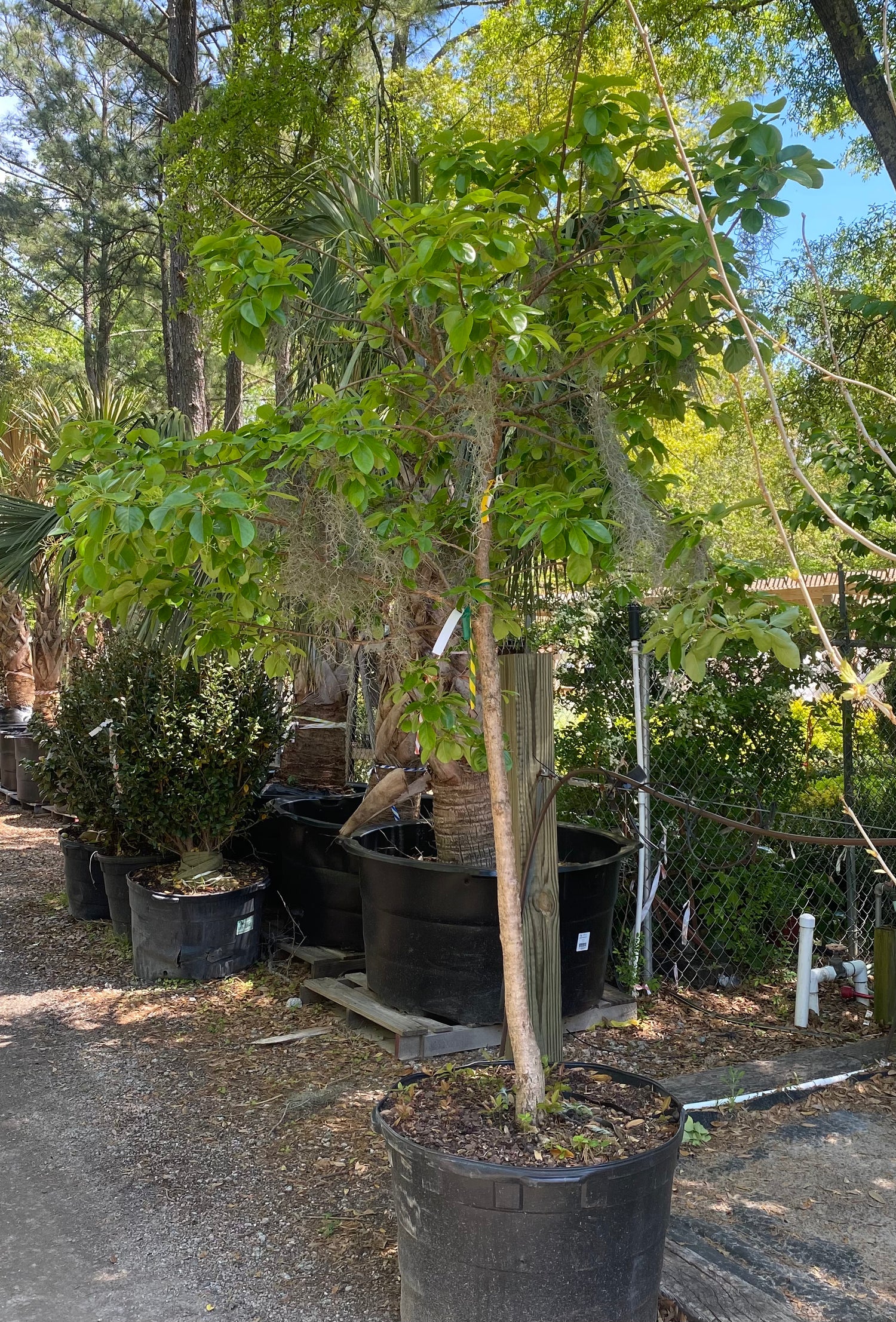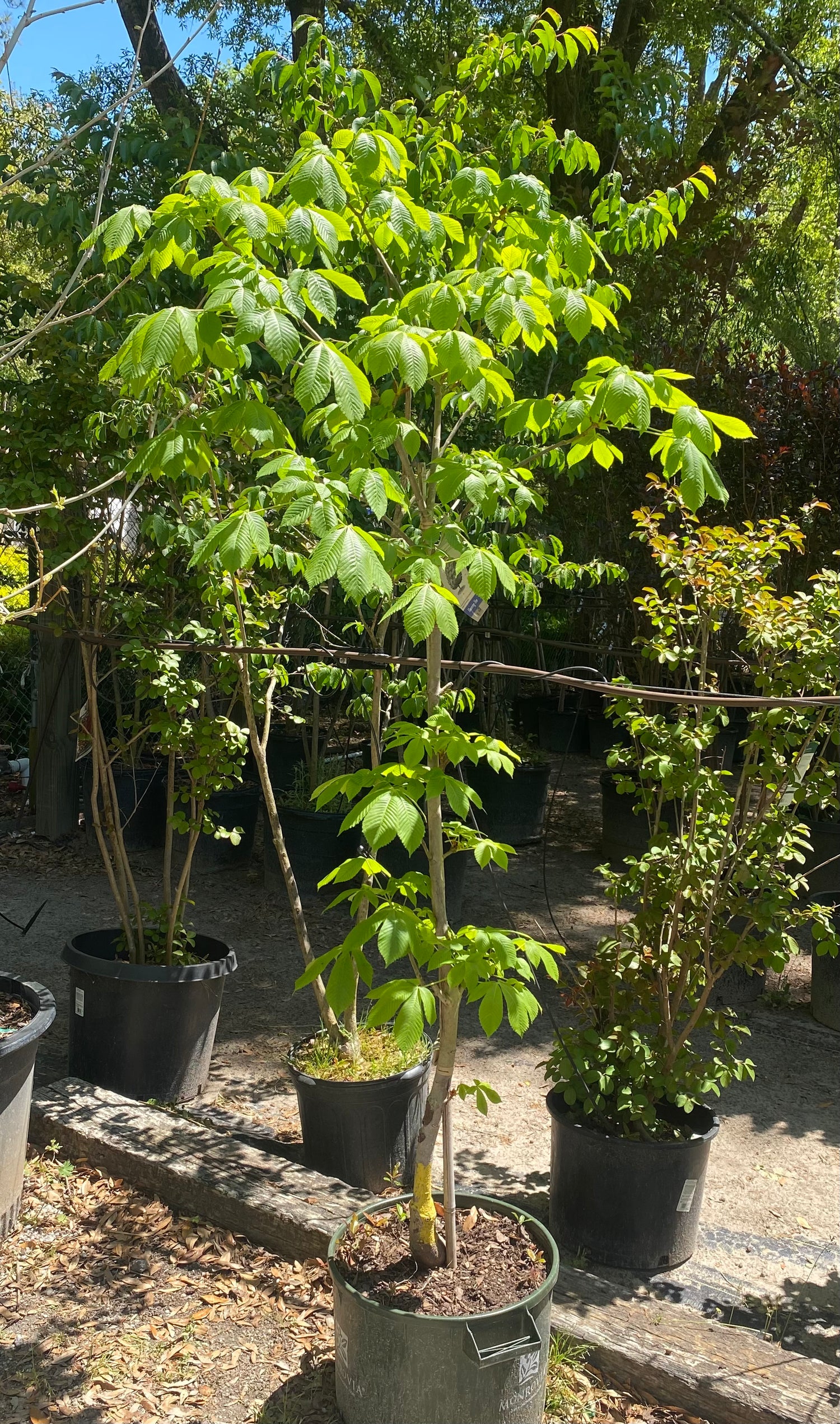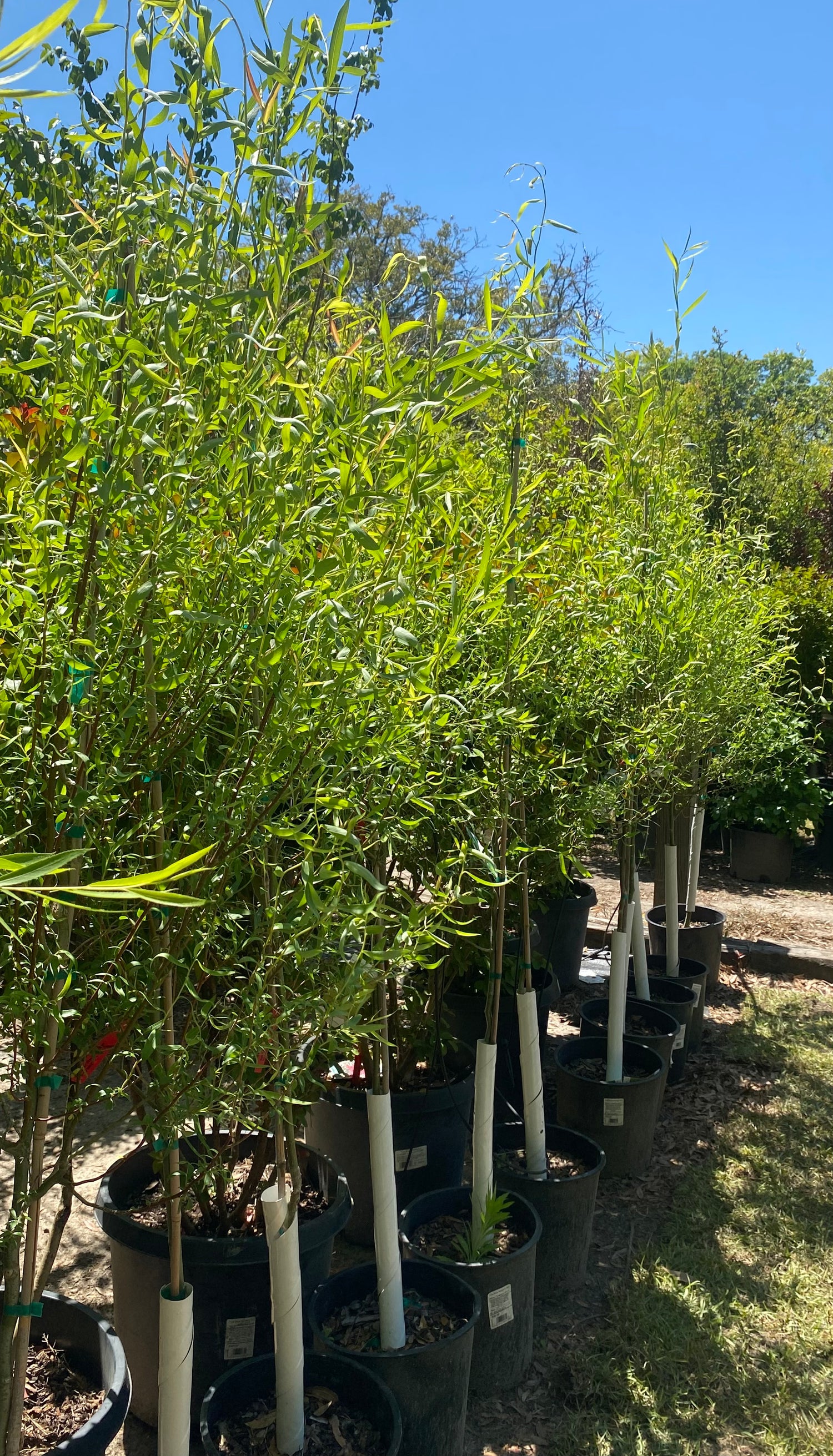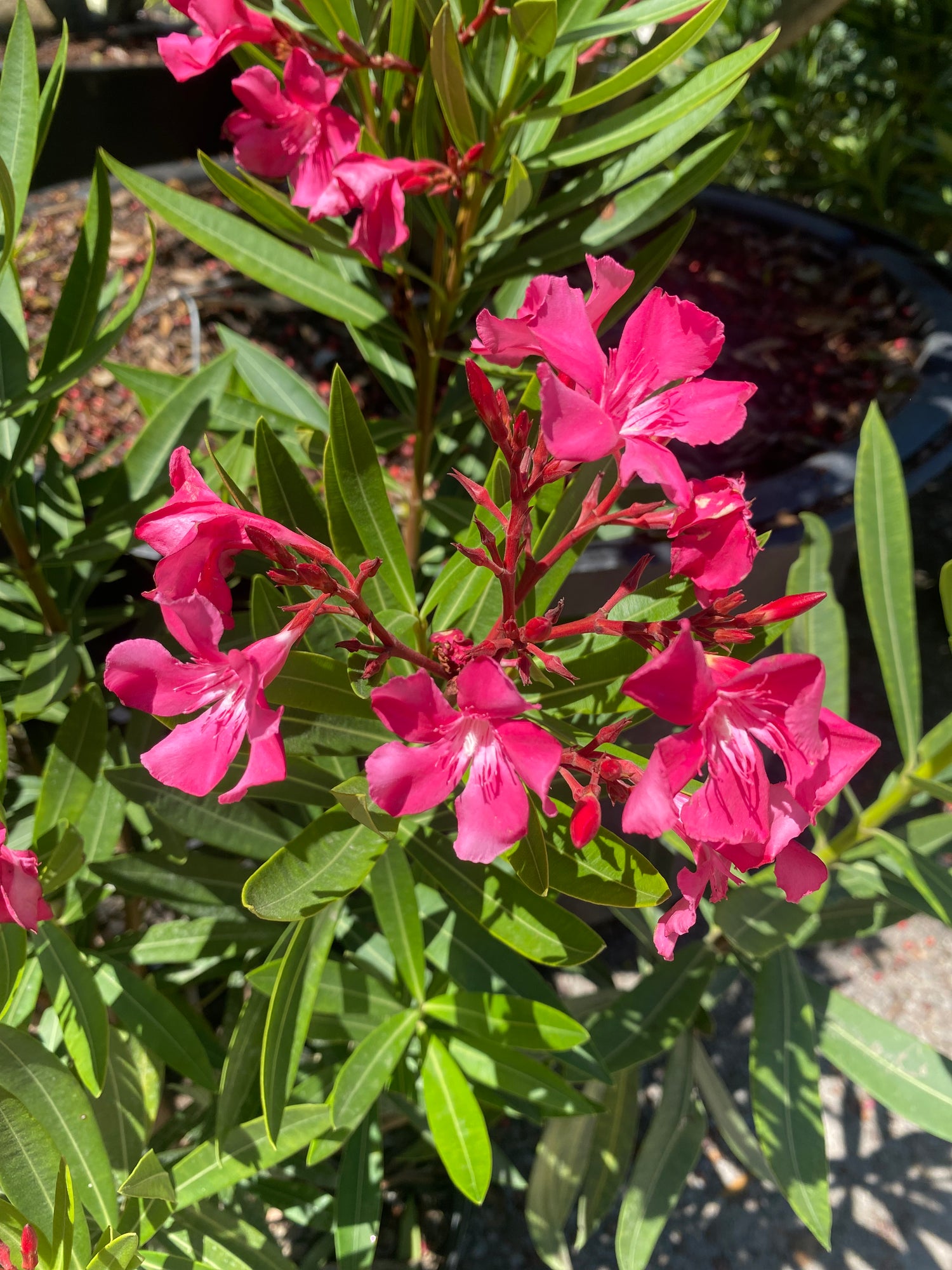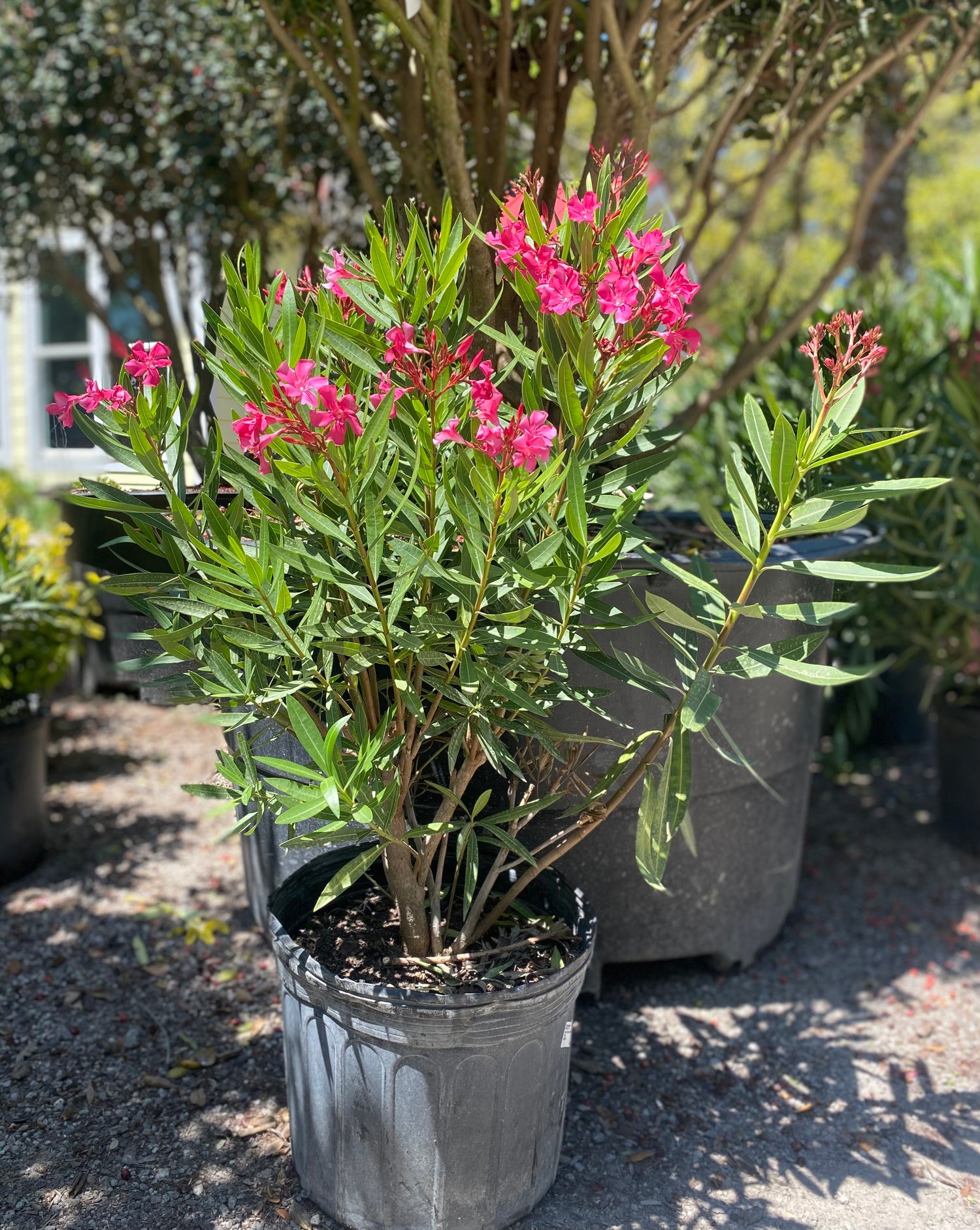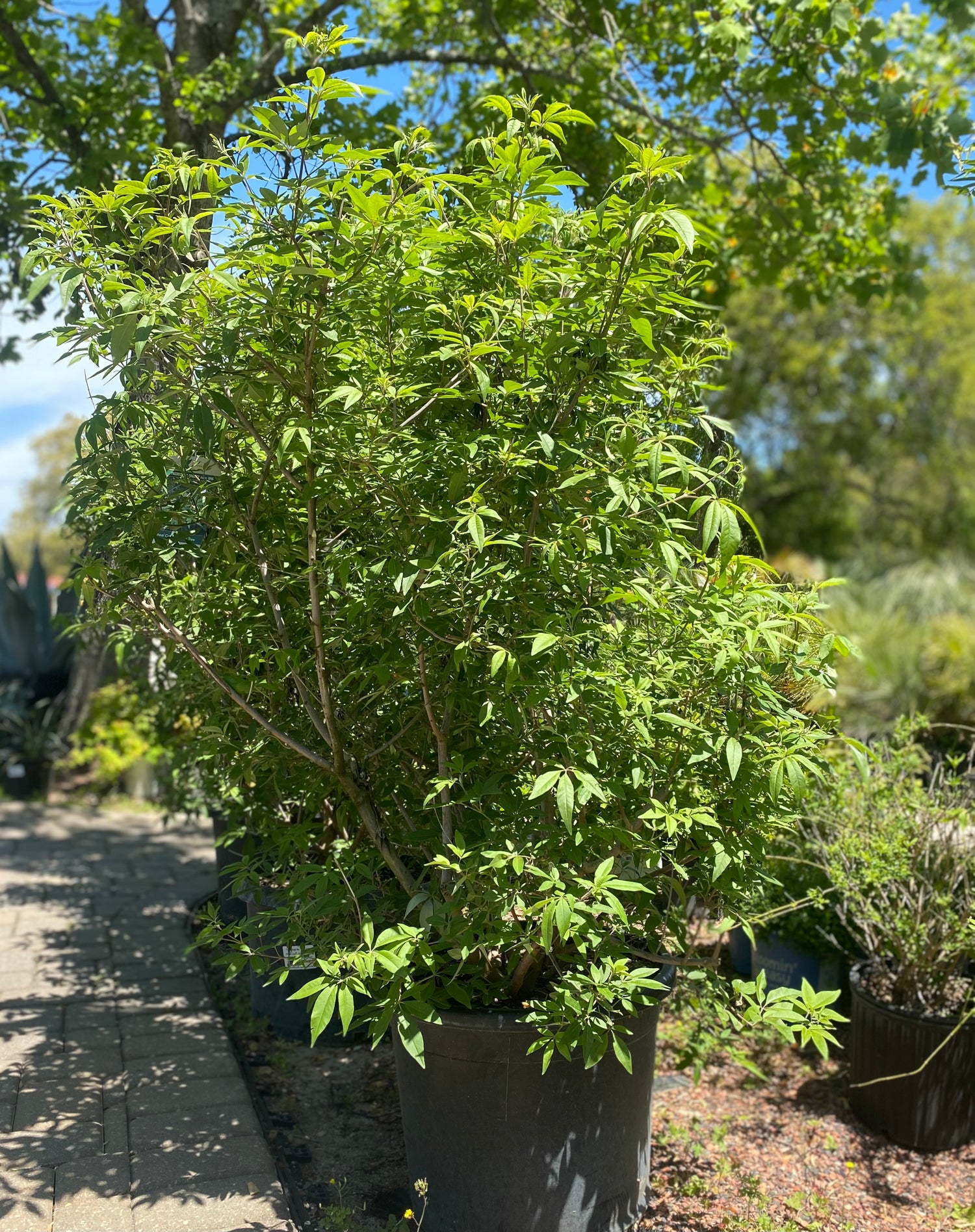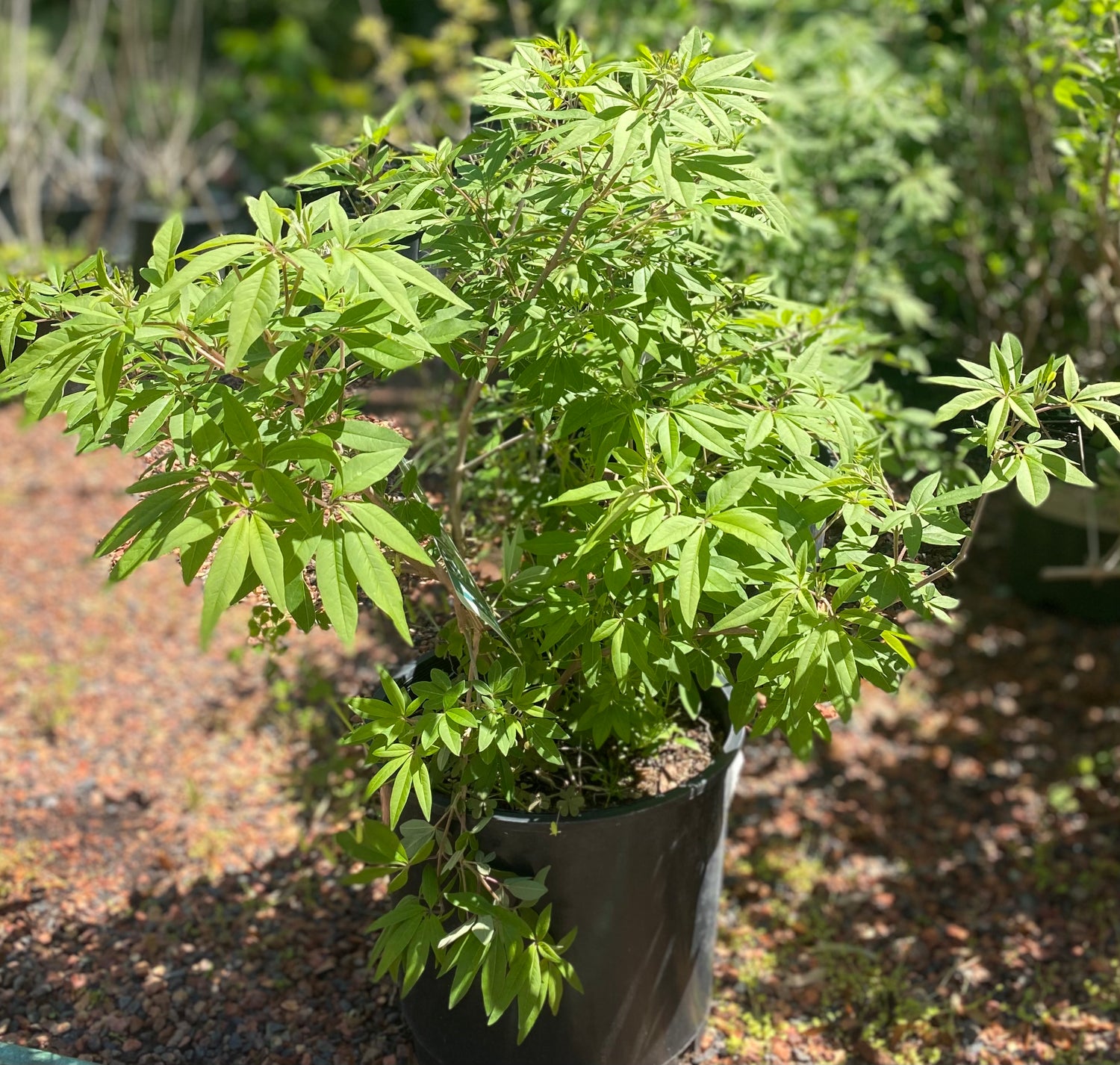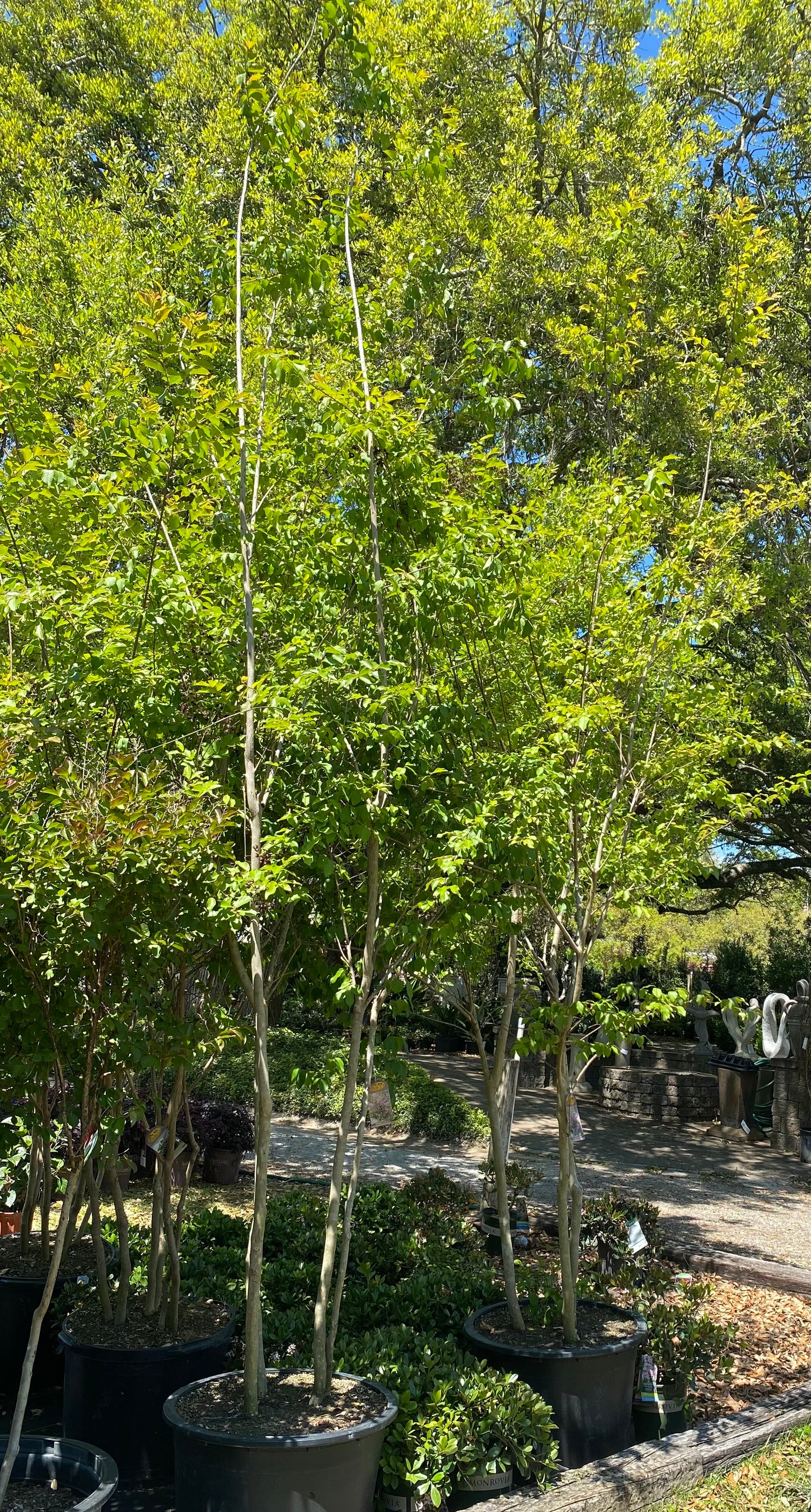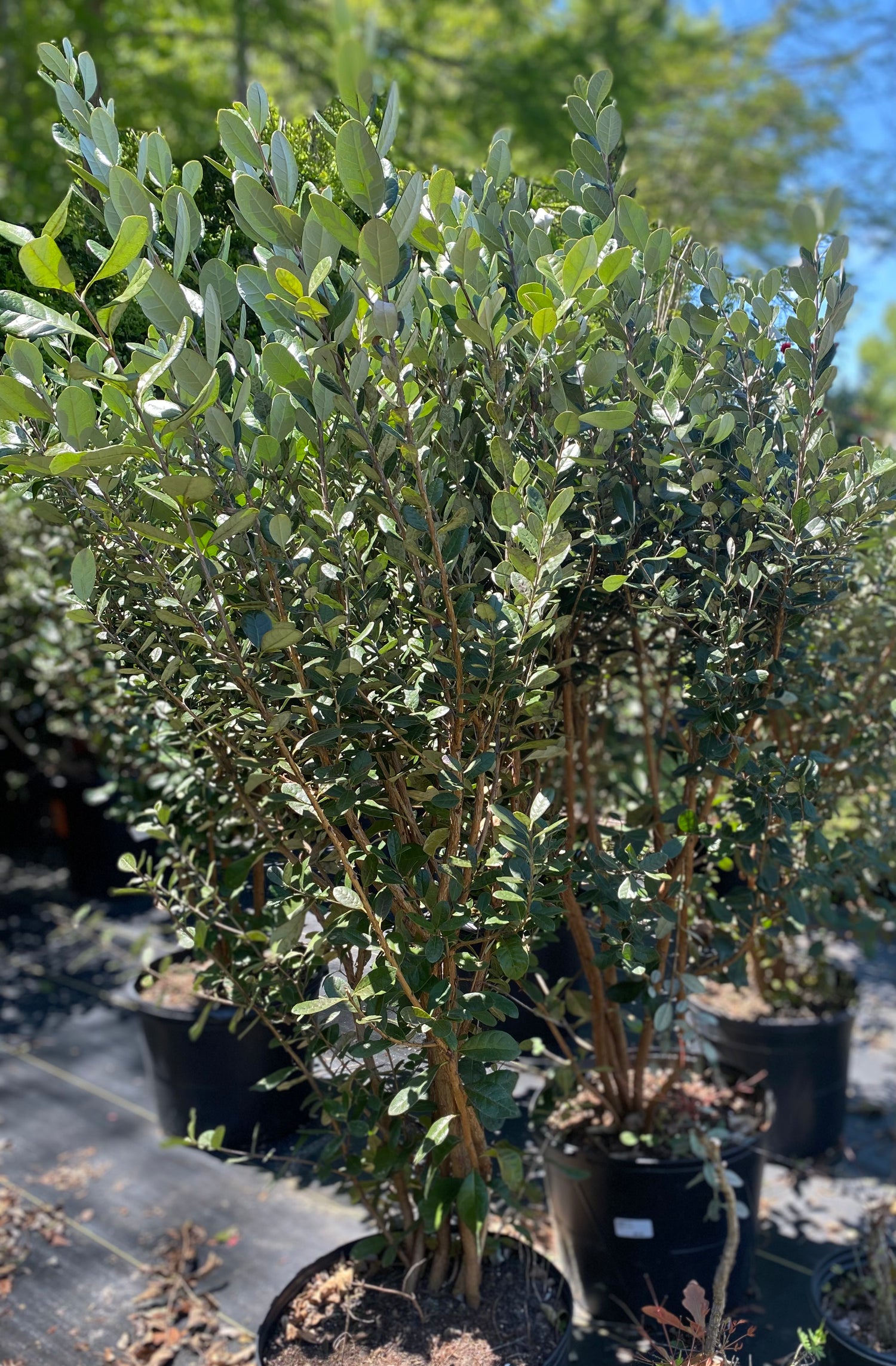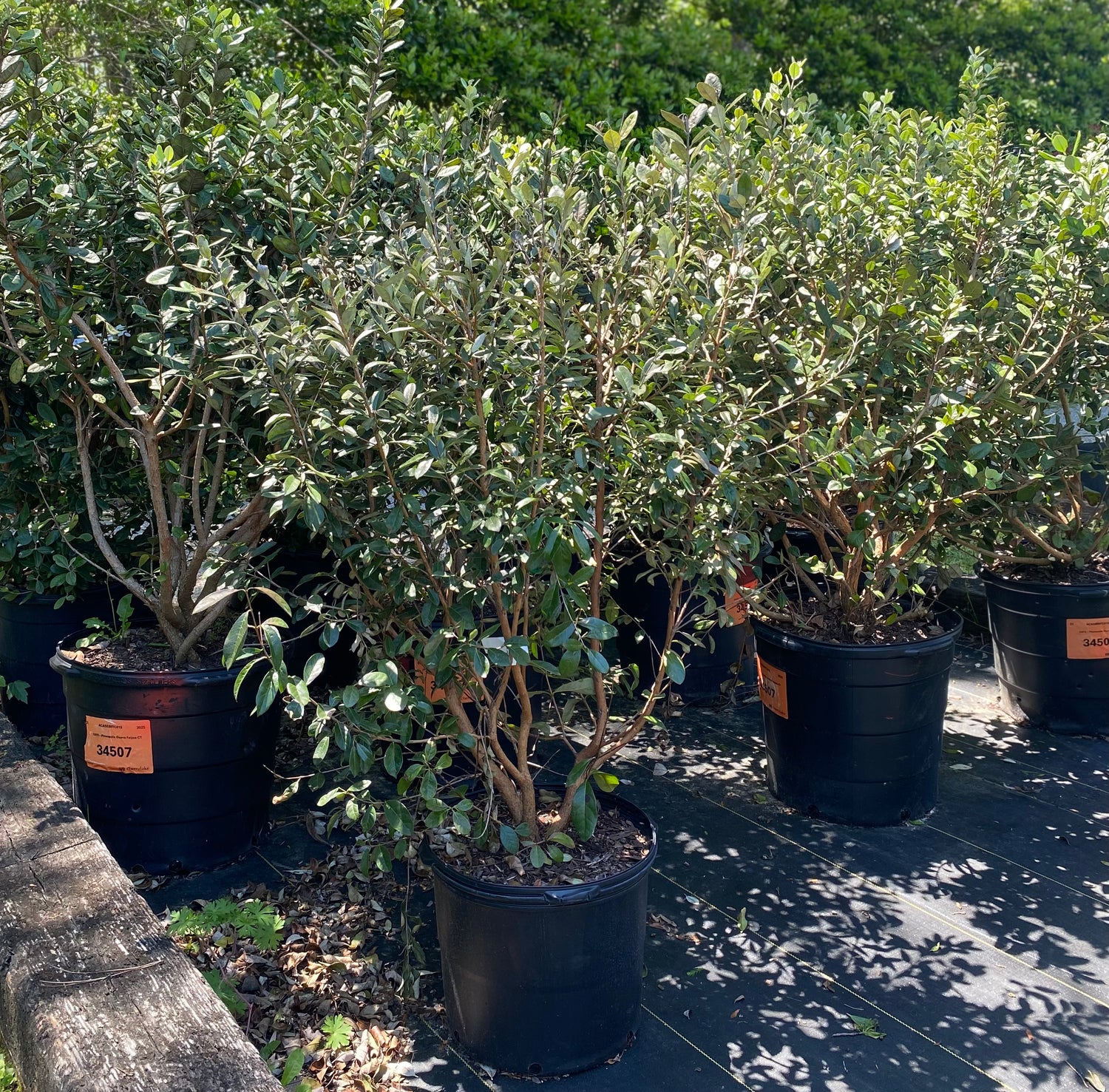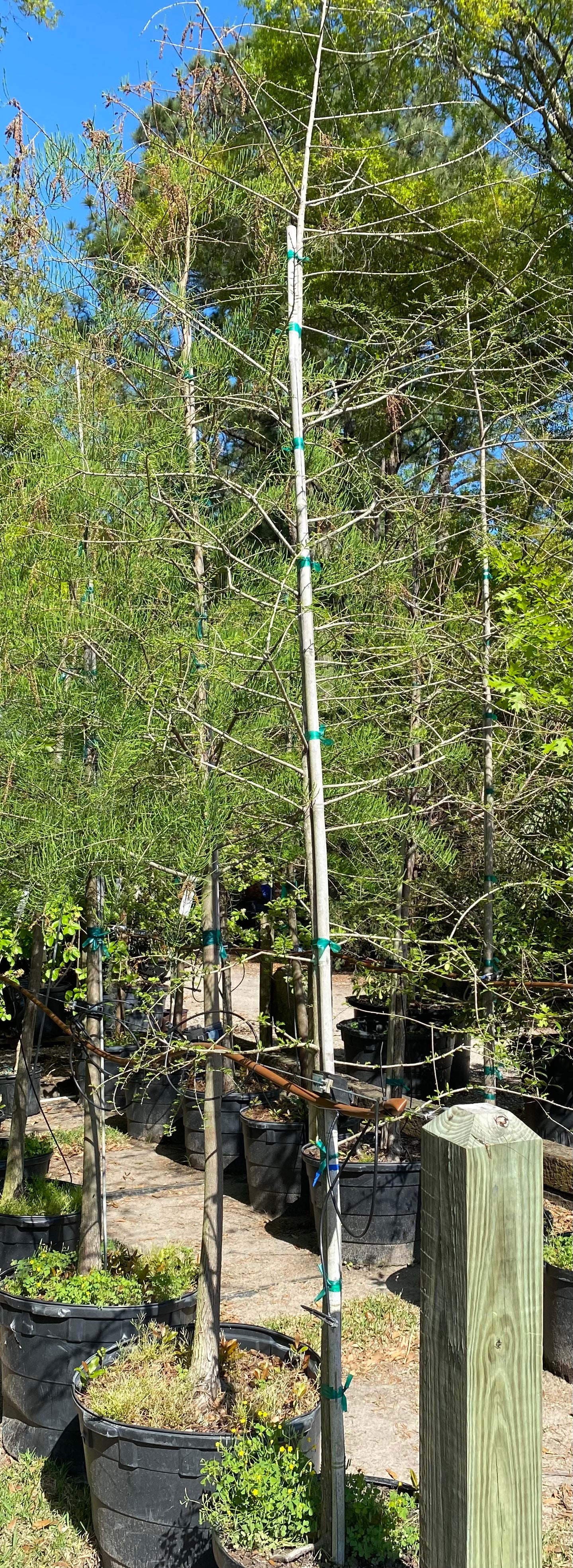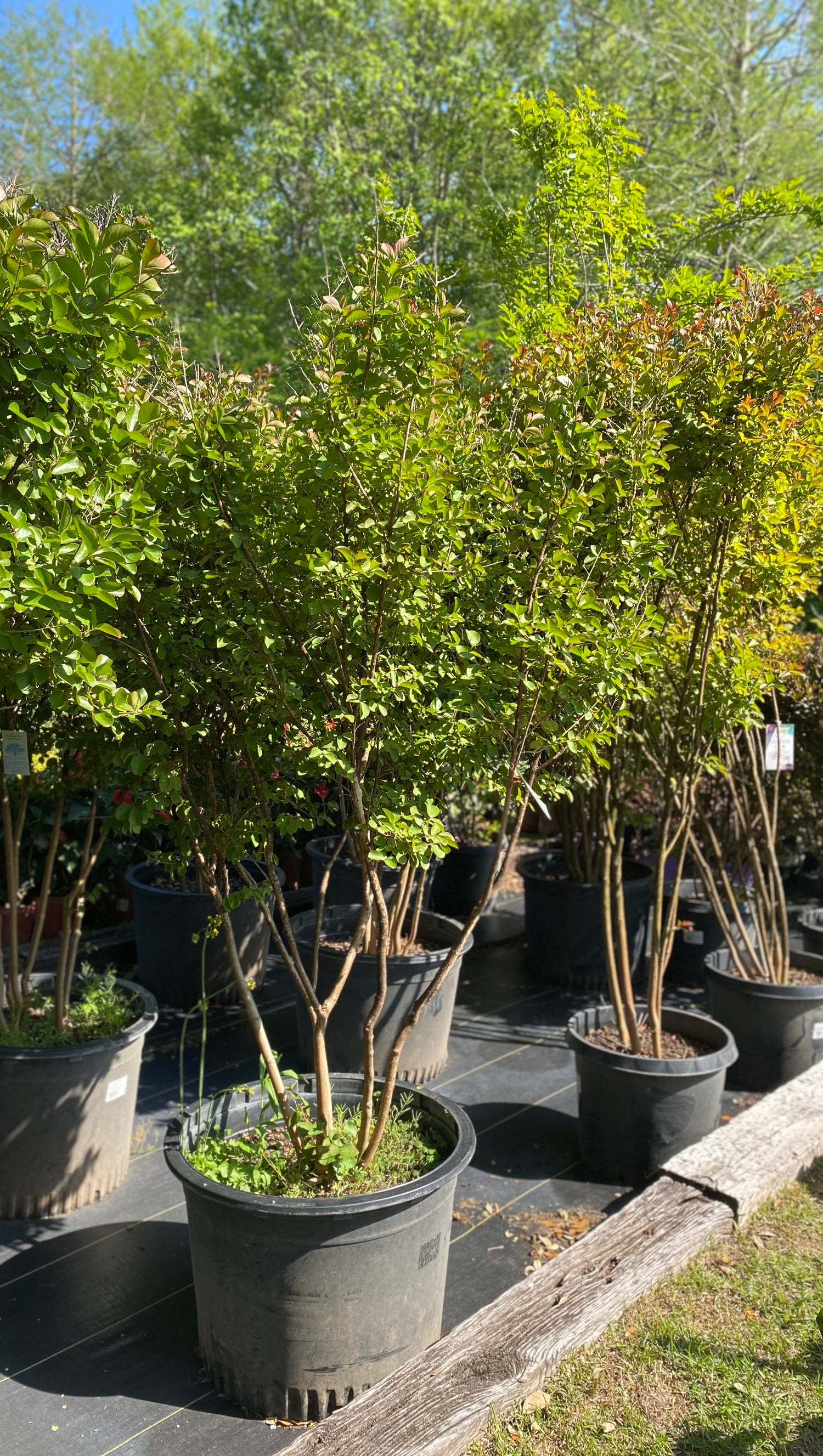Sort by:
Magnolia trees are prized for their stunning, fragrant blooms and graceful presence in the landscape. Whether evergreen or deciduous, these trees feature bold, glossy leaves and showy flowers that range from creamy white to soft pinks and vibrant purples, depending on the variety. Magolias are versatile and can be used as an elegant shade trees, focal points, or flowering accents. Many varieties are low maintenance and thrive in southern climates, offering year-round appeal and seasonal splendor.
Type: Evergreen Flowering Tree
Height: 15-40 feet
Spread: 10-30 feet
Hardiness: USDA Zones 6-10
Growth Rate: Moderate
Light: Full sun to partial shade
Soil: Well-drained, slightly acidic to neutral
Water: Moderate; drought tolerant once established
Foliage: Glossy green with rust colored undersides
Bloom Time: Late spring to summer
Flower Color: Creamy white
Fragrant: Yes, large, sweetly scented flowers
Low Maintenance: Yes
Features: Deer resistant, Heat tolerant, Great for screening and shade
The Orangeola Laceleaf Japanese Maple is a stunning ornamental tree known for its finely dissected foliage and cascading, weeping habit. New spring growth emerges vibrant orange-red, gradually maturing to deep burgundy through summer, and finishing with brilliant shades of orange and crimson in fall. Its compact, mounded form makes it perfect for small gardens, containers, or as a striking focal point in landscapes. Ideal for partial shade to full sun with well-draining soil, this elegant maple brings year-round interest and timeless beauty to any outdoor space.
Height: 4-8 feet tall
Spread: 6-10 feet wide
Hardiness: USDA Zones 5-9
Light: Full sun to part shade (best color in filtered sun)
Water: Regular, especially during dry periods
Soil: Moist, well drained, slightly acidic soil
Form: Weeping, cascading
Foliage Color: Orange-red in spring, deep burgundy in summer, bright red-orange in fall
Growth Rate: Slow to moderate
The Coral Bark Japanese Maple is a stunning small ornamental tree prized for its vibrant red-pink bark, which glows brightest in winter when the branches are bare. In spring, it leafs out with delicate lime-green foliage, which turns golden-yellow in fall, creating year-round visual interest. With its upright, vase-shaped form and slow growth habit, it's perfect for entryways, small gardens, patios, and Asian-inspired landscapes. This cold-hardy and low-maintenance tree adds elegance, structure, and vibrant color to any setting.
Height: 15-25 feet tall
Spread: 10-15 feet wide
Hardiness: USDA Zones 5-8
Light: Full sun to part shade
Water: Moderate; consistent moisture preferred
Soil: Moist, well draining soil; prefers slightly acidic soil
Growth Rate: Slow to moderate
Bark Color: Coral Red (brightest in winter)
Maintenance: Low
Brighten your garden or patio with the vibrant beauty and sweet fragrance of an Orange Citrus Tree. Known for their glossy green leaves, fragrant white blossoms, and juicy fruit, orange trees are perfect for growing in pots, planters, or directly in the ground in warmer climates. With proper care, they produce abundant blooms followed by delicious oranges, making them both decorative and rewarding to grow.
Mature Height (in ground): 10-20 feet
Mature Height (in container): 6-10 feet
Hardiness: USDA Zones 9-11 (outdoors year-round); container growing recommended in cooler zones (bring indoors during winter)
Growth Rate: Moderate
Light: Full Sun (6+ hours per day)
Water: Keep soil consistently moist but not soggy; allow top inch to dry between waterings
Bloom Time: Spring, with fruit maturing late fall to winter
Fruit: Sweet, edible oranges; fruiting typically begins 2-3 years after planting
Soil: Well draining, slightly acidic soil
Pollination: Self-pollinating, but outdoor trees can benefit from bees and natural pollinators
The Kumquat Tree, renowned for its compact size and ornamental appeal, produces small, oval or round orange fruits that are uniquely eaten whole - combining a sweet, edible peel with tart flesh. Native to Southeast Asia, kumquats are cherished for their fragrant white blossoms, glossy evergreen foliage, and adaptability to various growing conditions.
Plant Type: Evergreen fruiting shrub or small tree
Height: 6-12 feet tall
Spread: 4-8 feet wide
Hardiness: USDA Zones 9-11 (can be grown in containers in cooler zones)
Growth Habit: Compact, upright, and bushy
Light: Full sun
Water: They prefer consistent moisture, they are drought tolerant once established. Water deeply every 10 days during dry periods.
Foliage: Glossy, dark green leaves
Flowers: Fragrant white blooms in spring and summer
Fruit: Small, oval or round orange fruits with sweet peel and tart flesh
Tree with color-changing foliage; pink flowers
Eastern Redbud 'Flame Thrower'
Add a burst of color to your landscape with.the 'Flame Thrower' Redbud, a breathtaking variety of Cercis Canadensis known for its multi-colored foliage and spring blooms. New leaves emerge vibrant burgundy, transitioning to bright yellows, oranges, and greens, creating a layered, flame-like effect that lasts all season. In early spring, it produces rosy-purple flowers on bare branches before the foliage appears.
Compact and upright in form, this deciduous tree is ideal for small landscapes, garden focal points, or mixed borders. It's low maintenance, pollinator friendly, and brings year-round beauty with minimal care.
Height: 15-20 feet
Spread: 12-15 feet
Hardiness: USDA Zones 5-9
Common Name: Flame Thrower Redbud
Plant Type: Deciduous Flowering tree
Growth Habit: Upright, rounded
Bloom Time: Early spring
Flower Color: Rosy-purple
Foliage: Burgundy, yellow, orange, chartreuse (simultaneously)
Light: Full sun to part shade (best color in full sun)
Soil: Well-drained, average to rich soil
Water: Moderate; needs regular watering until established
Deer Resistant: Moderately (flowers may be browsed, but tree is usually avoided)
Pollinator Friendly: Yes - attracts bees
This stunning Acer palmatum 'Emperor I' Japanese Maple offers deep burgundy foliage and an elegant, upright form - expertly trained into a living screen with a 7-foot spread. Ideal for adding year-round beauty, shade, privacy, this boxed specimen is perfect for patios, courtyards, or along fences where space-saving vertical design is desired.
'Emperor I' is a hardy, low-maintenance Japanese maple known for its brilliant fall color, late bud break (protecting it from spring frost), and excellent branching structure. Grows well in full sun to part shade and adapts beautifully to containers or landscape beds.
Height (currently): 6-7 feet tall
Spread (currently): 7 feet wide
Growth Rate: Moderate
Mature Height: 12-15 feet
Mature Spread: 10-12 feet
Light: Full sun to part shade
Hardiness: USDA Zones 5-8
Foliage Color: Deep red to burgundy (holds color well through summer)
Fall Color: Bright crimson red
Soil: Moist, well-drained, slightly acidic soil
Water Needs: Moderate - prefers consistent moisture
Features: Hand trained into screen shape for instant impact, Excellent for tight spaces or container growing, Later bud break (less frost damage)
The Chinese Fringe Tree is a beautiful, small to mid-sized tree prized for its cloud-like clusters of fragrant, white fringe-like flowers that bloom in late spring. With its rounded canopy, peeling bark, and glossy green foliage, it adds charm and elegance to gardens, courtyards, or landscape borders.
Very adaptable, tolerates pollution, compacted soils, and drought once established. It's a standout specimen tree with exceptional ornamental value from spring through fall.
Height: 15-25 feet
Spread: 15-20 feet
Hardiness: USDA Zones 5-9
Growth Rate: Moderate
Form: Rounded to oval canopy
Light: Full sun to part shade
Soil: Well-drained; tolerant of a wide range of soils
Water Needs: Moderate; drought tolerant once established
Bloom Time: Late spring
Flower Color: White, airy, fringe-like clusters
Fragrance: Yes - sweet and light
Foliage: Glossy green, turning golden yellow in fall
Maintenance: Low
Pollinator-Friendly: Yes
The Fort McNair Red Horse Chestnut is a majestic ornamental tree known for its upright, rounded canopy and show-stopping clusters of bright pink to red flowers with yellow centers in late spring. Its rich, glossy green foliage provides excellent summer shade, followed by large, decorative seed capsules in the fall.
This cultivar is prized for its resistant to leaf scorch and leaf blotch, offering cleaner summer foliage than traditional varieties. Ideal for lawns, large gardens, parks, or street plantings, Fort McNair brings both structure and beauty to the landscape with minimal maintenance.
The Babylon Weeping Willow is one of the most iconic and graceful landscape trees, known for its arching, pendulous branches that sway in the breeze and create a soft, romantic canopy. Its bright green, lance-shaped leaves flutter gently from spring through fall, turning golden yellow before dropping in autumn.
Fast growing and elegant, this tree is ideal for large open spaces, water features, and low-lying areas where its roots can access consistent moisture. Its timeless silhouette makes it a stunning specimen tree with high visual impact.
Height: 30-50 feet
Spread: 30-40 feet
Hardiness: USDA Zones 6-9
Growth Rate: Very fast
Form: Graceful, wide-spreading with weeping branches
Light: Full sun to part shade
Soil: Prefers moist, well-drained soil; tolerates clay and occasional flooding
Water Needs: High; thrives near water but tolerates brief dry periods
Foliage: Narrow, bright green leaves that turn golden yellow in fall
Maintenance: Moderate - may require pruning to manage size and shape
Features: Heat tolerant
The Bosque Elm is a fast-growing, upright shade tree known for its graceful, vase-shaped form, deep green foliage, and excellent adaptability. A cultivar of Chinese Elm, it features glossy leaves that turn a rich reddish-purple in fall, along with attractive, mottled bark that provides winter interest.
Highly tolerant of drought, heat, and poor soils, Bosque Elm is ideal for street plantings, large landscapes, and shade canopies. It is also resistant to Dutch elm disease, making it a reliable and long-lasting choice for modern landscapes.
Height: 50-60 feet
Spread: 35-45 feet
Hardiness: USDA Zones 5-9
Growth Rate: Fast
Form: Upright, vase-shaped
Light: Full sun
Soil: Adaptable to a variety of soils; prefers well drained
Water Needs: Low to Moderate; drought tolerant once established
Foliage: Glossy green leaves turning reddish-purple in fall
Bark: Exfoliating bark in shades of gray, orange, and brown - very ornamental
Maintenance: Low
Features: Disease Resistant, heat tolerant, drought tolerant, moderately deer resistant
Oleander is a fast growing evergreen shrub or small tree known for its lush green foliage and clusters of hot pink, fragrant flowers that bloom from spring through fall. This sun loving beauty brings a clean, tropical feel to yards, hedges, and containers.
Oleander is drought tolerant, heat loving, and thrives in poor soil, making it a go to for low maintenance color in warm climates. Its upright, bushy growth can be pruned to form a dense screen, small tree, or formal hedge
Light: Full sun
Height: 6-12 feet (can be pruned lower or grown taller as a tree)
Spread: 4-8 feet
Hardiness: USDA Zones 8-11
Foliage: Evergreen
Bloom Time: Spring to fall
Water: Low once established
Maintenance: Low
Deer Resistant: Yes
Fragrant: Yes
Toxic if Ingested: Yes, not for pets or livestock areas
The Shoal Creek Chaste Tree is a fast-growing, multi-stemmed deciduous shrub or small tree prized for its aromatic, gray-green foliage and long spikes of vibrant lavender-blue flowers that bloom from summer into early fall. Loved by pollinators and gardeners alike, this sun-loving plant adds bold color, fragrance, and texture to warm-climate landscapes.
'Shoal Creek' is one the most vigorous and mildew resistant varieties of chaste tree, making it ideal for low-maintenance, drought tolerant, and pollinator friendly gardens. Whether grown as a large shrub or small ornamental tree, it delivers standout beauty and seasonal interest.
Type: Deciduous flowering shrub or small tree
Height: 10-15 feet
Spread: 8-12 feet
Hardiness: USDA Zones 6-9
Growth Rate: Fast
Light: Full sun
Soil: Well-drained; tolerates poor or sandy soil
Water Needs: Low once established; drought tolerant
Bloom Time: Summer to early fall
Flower Color: Lavender-blue flower spikes
Maintenance: Low; prune in late winter for shape
Features: Fragrant-both foliage and blooms, deer resistant, pollinator friendly, mildew resistant.
This is an ornamental tree known for its lavender-purple blooms, exceptional mildew resistance, and extended flowering period that lasts up to 120 days. This fast-growing, upright tree adds vibrant summer color and elegant bark texture to landscapes, while its smooth, peeling trunk and rich green foliage bring year-round interest.
Ideal for driveways, privacy screens, or focal points, Muskogee thrives in heat and sun, making it one of the best choices for Southern gardens. Low maintenance and drought tolerant once established, it brings both beauty and resilience to the garden.
Height: 20-25 feet
Spread: 15-20 feet
Hardiness: USDA Zones 7-10
Growth Rate: Fast
Light: Full sun
Water Needs: Low once established
Bloom Time: Summer through early fall (up to 4 months)
Flower Color: Lavender-Purple
Foliage: Dark green leaves turn reddish-orange in fall
Bark: Smooth, cinnamon-colored and peeling - highly ornamental
Maintenance: Low
Deer Resistant: Yes
Pollinator-Friendly: Yes
A true multipurpose gem, Pineapple Guava offers beauty, flavor, and function all in one plant. This evergreen shrub or small tree feature silvery green foliage, striking red and white edible flowers in spring, and delicious, tangy-sweet fruit in late summer to fall that tastes like a blend of pineapple, mint, and banana.
Highly ornamental and low maintenance, it's ideal for use as a hedge, privacy screen, or fruiting accent tree. Drought tolerant and heat loving, Pineapple Guava thrives in full sun and well drained soil, making it a perfect choice for edible landscapes or Mediterranean style gardens.
Edible petals & Edible green fruit with soft, aromatic flesh (ripens late summer to fall)
Height: 8-15 feet
Spread: 6-10 feet
Hardiness: USDA Zones 8-11
Growth Rate: Moderate
Light: Full sun to part shade (more fruit production in full sun)
Water Needs: Low to moderate
Bloom Time: Late spring to early summer
Maintenance: Low - prune for shape or size as needed
Features: Pollinator-Friendly, deer resistant, edible
The Pond Cypress is a graceful, deciduous conifer known for its narrow, upright form and soft, feathery foliage that turns a warm coppery orange in fall. A close relative of the bald cypress, it thrives in both wet and average soils, making it ideal for pond edges, rain gardens, or low-lying areas. Unlike bald cypress, it typically grows more columnar and produces fewer 'knees' (exposed roots).
Resilient and long-lived, Pond Cypress is both flood and drought tolerant once established. Its sculptural shape and seasonal color make it a striking choice for naturalistic and formal landscapes alike.
Height: 50-70 feet
Spread: 10-15 feet
Growth Habit: Upright, narrow pyramidal form
Light: Full sun
Hardiness: USDA Zones 5-9
Foliage: Soft green needles; turn coppery-orange in fall
Water Needs: Moderate to High; flood tolerant once established
Growth Rate: Moderate to fast
Maintenance: Low
This plant lives up to its name with an explosion of vibrant cherry red blooms that last from midsummer into early fall. This deciduous ornamental tree offers four-season appeal - with showy flowers, attractive peeling bark, glossy green foliage, and stunning orange-red color. Its upright, rounded form makes it perfect as a specimen tree, accent, or in grouping along fences and driveways.
Drought tolerant, heat-loving, and resistant to powdery mildew, Dynamite is a low maintenance favorite for southern landscapes.
Height: 15-20 feet
Spread: 10-15 feet
Hardiness: USDA Zones 7-9
Growth Habit: Upright, rounded canopy
Light: Full sun
Bloom Time: Midsummer to early fall
Flower Color: Bright cherry red
Foliage: Glossy green, turning orange-red in fall
Bark: Light brown to gray, exfoliating for multi-season interest
Water Needs: Low once established
Maintenance: Low - prune in late winter if shaping is needed
Deer resistance: Yes

